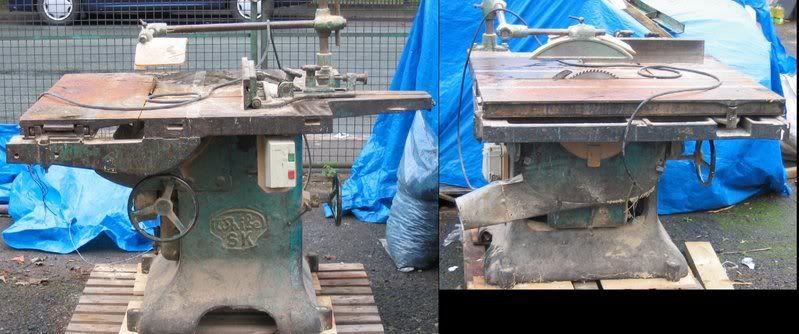caretaker":bbn1xnpd said:
(I).... am concerned about the safety of my fingers on my table saw, would there be other ways to guard them from the blade, say a moving sledge, and over the work a see through plastic cover. Perhaps the guard that is used now is out of date and needs updating.
In commercial terms the introduction of the sliding carraige panel saw with a SUVA overhead crown guard has pretty much addressed a lot of the safety concerns and this type of saw in the form of MiniMax, Felder, Hamer, Lurem-Metabo, Rojek, Ixes, etc has now reached the upper end of the hobby market. The Chinese/Taiwanese/Americans on the other hand seem to be driven solely by cost - and that's never positive for safety IMHO. BTW, non of this was new technology, as almost all the elements were in place in that dimension saw design I showed earlier in the thread - a design of the 1930s (and not unique as every major British and American manufacturer produced similar models) - so I don't think there is any need to redesign anything, just a need for a greater appreciation of what the equipment's safe limitations, how to extend them by the sensible use of well-desoigned jigs and maybe a bit of quiet pressure on the manufacturers to be more safety concious (I hope)
gidon":bbn1xnpd said:
However the average woodworker builds a router table, slings a very powerful router in and does all sorts of crazy things with it that they are told they shouldn't do on a table saw thinking they are safe to do them on the router table. But often they are not - or need careful guarding (which can often be tricky).
Surely, though, this is the same old problem - lack of understanding? Most safety engineers work on the assumption that if you can see a cutter it's a potential danger whereas the average woodworker seems intuitively to distrust what he measures and sets (fences, that is) and insist on seeing the cutting process working. Let's hope they never make cheap enough home laser woodworking kits or there'll be more than a few people performing unintended DIY laser eye surgery :roll:
gidon":bbn1xnpd said:
And the physics of router tables are much more confusing than table saws. Feeding against the rotation of the cutter is not as intuitive as most books or manuals make out - it takes some thought. And a 2000W router has a scary amount of torque.
But you're actually feeding against the cutting action on just about everything you use in a woodworking shop - radial arm saw, spindle moulder, table saw, planer, router table, thicknesser, etc all feed against the cut. The problem comes in understanding which direction the cutter is rotating in and then in remembering that the cutter needs to be rotating in such a way that the work is automatically pushed into the fence and back at the operator. To that end in trade shops you'll frequently find dirty big arrows drawn on machinery in black chinagraph
gidon":bbn1xnpd said:
Are router tables used in commercial shops - if so are there any guidelines?
You do seem them from time to time, although in the main most trade shops starting out with a router table tend to move to a spindle moulder pretty quickly as the spindle is cheaper to run (tooling costs), makes a smoother cut, takes a bigger cut (making things like door-size M&Ts a reality), in a single pass, is quieter, etc. In terms of use, though, a router table has to be treated the same as a spindle moulder as they are, in effect, the same. So the HSE guidelines are
these. BTW these HSE woodworking fact sheets aren't nanny state missives, but actually do contain a lot of genuinely useful information
I always find the biggest problems occurring when doing jobs where it is necessary to switch between the spindle moulder (fed from the right), to a pin router with fence or with a guide pin and templet (fed from left) and back again. In that case there is a potential danger of forgetting what you're working on and feeding from the wrong side unless you are paying attention.
johnnyb":bbn1xnpd said:
... now I never use them for anything other than there obvious uses. Large cutters no, no, no.
Oddly enough I'm perfectly at home running 200mm to 250mm diameter panel raisers on the spindle moulder and I'm even OK with ring fence work (bonnet and ring) which used to give me the willies, but then one of the things I did learn was that you can make things a lot less fraught by removing as much waste as possible on the bandsaw (for curved work) or by hogging away with a rebate cutter (large panels, etc). Reducing the amount of material your cutter gas to remove also increases the life of the tips. This doesn't mean that I'm blasée - I still check and double check tooling and guarding every time I set-up a job. What works on the spindle moulder works just as well on the router table I'd say
Scrit



































